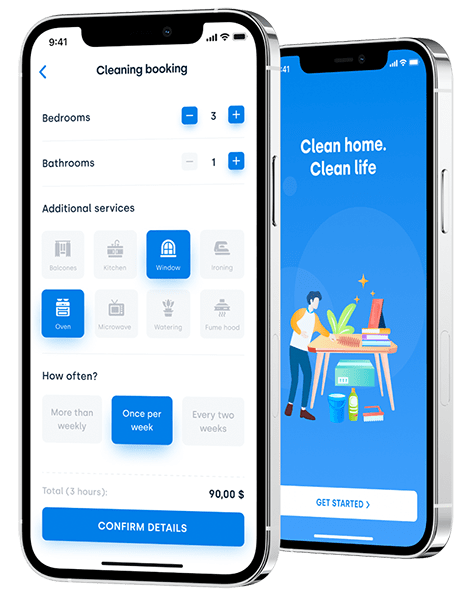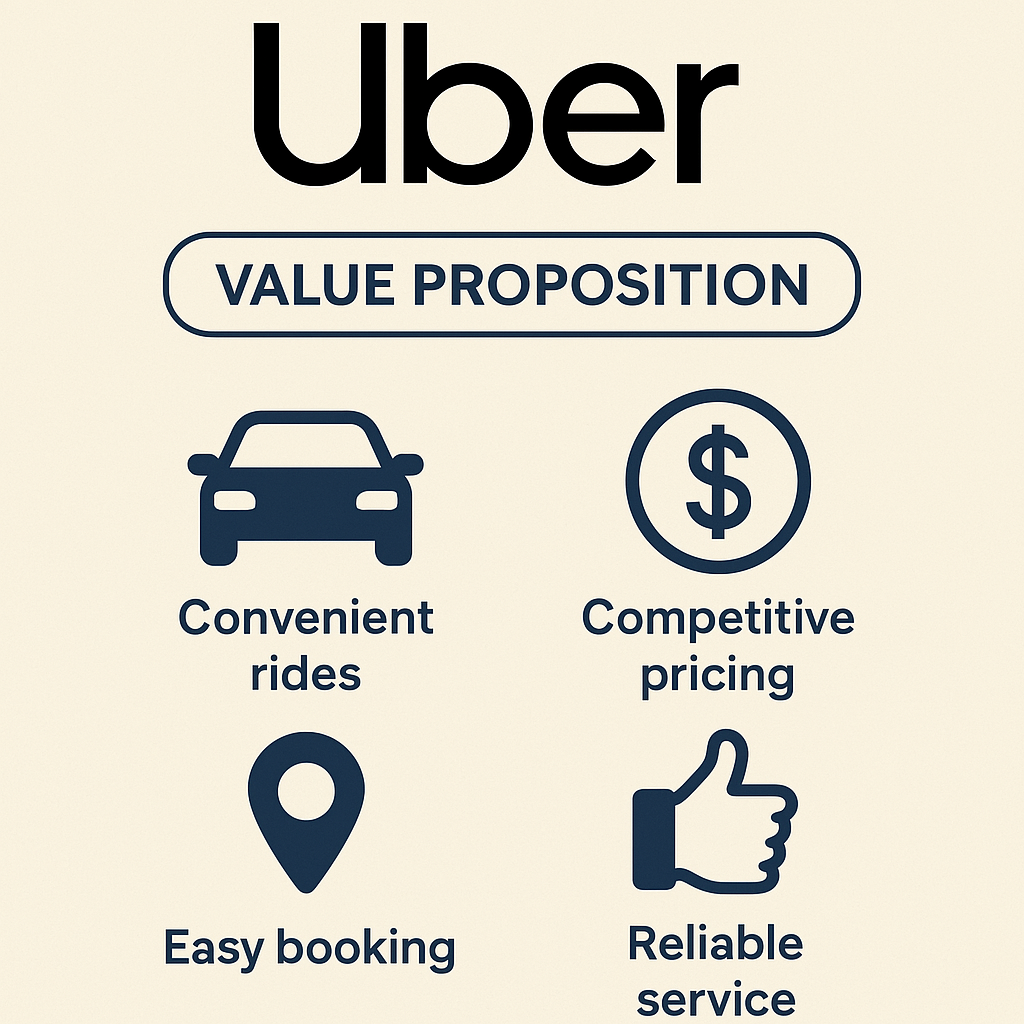
Vabra is an on-demand system for cleaning services. This Uber-style application makes your life simple: now you can order cleaning with just a few clicks!
Uber has revolutionized the transportation and mobility industry with its on-demand, app-based service that connects riders and drivers worldwide. With a customer-centric approach, innovative technology, and diverse service offerings, Uber has created a compelling value proposition that addresses the needs of multiple stakeholders—riders, drivers, and cities. This article explores Uber’s value proposition through its core components: convenience, affordability, safety, income opportunities, and technology, along with a breakdown of how these components contribute to the company’s competitive advantage.

1. Convenience: On-Demand Access to Rides
Problem: Traditional transportation often lacks real-time availability, especially in regions with limited access to public transit or taxi services.
Solution: Uber offers an easily accessible platform where riders can book a ride at any time and any location (within operational boundaries). The platform’s availability and ease of access make it a convenient alternative to public transportation and private car ownership.
Features that Enhance Convenience:
- Location Tracking: Riders and drivers can track each other in real-time, allowing for easy pickup and route tracking.
- Multiple Ride Options: Uber provides various ride options, such as UberX, UberPOOL, and UberBLACK, tailored to different preferences and budgets.
- Cashless Payments: Integrated payments allow riders to pay through the app, eliminating the need for cash and easing transaction processes.
This focus on convenience has been essential to Uber’s success and has redefined the user experience in urban mobility. For example, UberPOOL provides a ride-sharing experience that reduces costs for riders and traffic congestion in urban areas, showing how convenience aligns with broader community needs.
2. Affordability: Competitive Pricing Strategy
Problem: Private transportation options, like taxis, can be costly, particularly during peak hours or in regions with limited public transit.
Solution: Uber’s pricing algorithm adjusts dynamically, offering lower prices in less crowded times and locations. While surge pricing applies during high-demand periods, Uber’s average costs are typically lower than traditional taxi fares, making it an affordable option.
Pricing Table: Comparison of Uber vs. Traditional Taxis
| Criteria | Traditional Taxi | Uber |
|---|---|---|
| Base Fare | Fixed per city | Varies per city |
| Pricing During Peak Hours | High | Surge Pricing |
| Payment Options | Mostly cash-based | Cashless (in-app) |
| Cost Efficiency | Often higher | Typically lower on average |
This affordability, combined with UberPOOL, allows multiple riders to share the same route, lowering costs for individual riders while maintaining profitability for the company. Uber’s affordability also broadens access to private transportation for diverse income groups, adding to its customer appeal.
3. Safety and Trust: Commitment to Security
Safety is a critical part of Uber’s value proposition, as it addresses one of the main concerns associated with ridesharing—trust and security.
Problem: Concerns over rider and driver safety, especially in unregulated environments, can deter users.
Solution: Uber has implemented several safety features to reassure both riders and drivers, building a sense of security around its platform.
Uber’s Safety Features:
- Driver Screening: Background checks and screenings for all drivers.
- In-App Emergency Assistance: The app provides an emergency button, allowing riders or drivers to quickly alert local authorities.
- Trip Sharing: Riders can share trip details with friends or family members to track the ride in real-time.
- Rating System: Both drivers and riders rate each other after each trip, creating accountability and maintaining quality standards.
These measures enhance trust and make Uber a more secure transportation option than many unregulated alternatives. The safety commitment also fosters loyalty and differentiates Uber in the competitive ridesharing market.
4. Income Opportunities for Drivers
Uber’s value proposition is not limited to its riders; it also significantly benefits drivers, offering flexible earning opportunities that appeal to a wide demographic, from part-time workers to full-time earners.
Problem: Many individuals seek flexible work that can be balanced with other commitments, while traditional jobs often demand rigid schedules.
Solution: Uber’s driver-partner model provides flexibility, allowing drivers to set their own hours and work around their schedules.
Income Flexibility and Benefits for Drivers
| Feature | Description |
|---|---|
| Flexible Hours | Drivers can work whenever they choose. |
| Income Transparency | Drivers see earnings in real time through the app. |
| Incentives and Bonuses | Additional earnings are provided during peak times or for high ratings. |
| Driver Support | Uber offers resources and support to its driver community. |
By offering these benefits, Uber caters to a segment of the workforce seeking gig-based income solutions, positioning itself as an attractive platform for independent workers. This model also benefits Uber by ensuring a large, on-demand workforce without traditional employment costs.
5. Advanced Technology: An Integrated Digital Experience
Technology is at the heart of Uber’s operations, enabling efficient matching, route optimization, and seamless payment processing. Uber’s investment in technology is integral to its value proposition and enables the company to enhance both rider and driver experiences continuously.
Key Technological Innovations:
- GPS and Route Optimization: Real-time location tracking and optimized routing improve ride efficiency and reduce waiting times.
- Machine Learning for Demand Prediction: Uber’s algorithms predict demand surges, which helps in planning resource allocation and managing prices dynamically.
- Payment Integration: The app’s built-in payment system supports multiple payment options, including credit, debit, and digital wallets.
- User Interface and Experience: Simple and intuitive app design enhances usability, making Uber accessible to users across age groups and tech proficiency levels.
Uber’s technology-driven approach not only streamlines the user experience but also minimizes operational costs, enabling it to remain competitive while providing top-tier services.
6. Social and Environmental Impact: Sustainable Urban Mobility
Uber has increasingly invested in initiatives to promote sustainability, recognizing the importance of its environmental footprint.
Problem: Urban congestion and pollution are significant issues in densely populated cities.
Solution: Uber’s carpooling options, such as UberPOOL, and its push towards electric vehicles (EVs) and bike rentals reduce the environmental impact of urban travel.
Sustainable Initiatives
| Initiative | Impact |
|---|---|
| UberPOOL | Reduces the number of vehicles on the road, lowering emissions and congestion. |
| Electric Vehicles Program | Promotes the use of electric vehicles among drivers with added incentives. |
| Micromobility Options | Offers bikes and scooters as alternatives to cars, especially for short-distance travel. |
These initiatives help Uber align its value proposition with sustainable mobility goals, adding an environmentally conscious dimension to its brand. For example, Uber’s partnership with electric vehicle manufacturers provides drivers with incentives to switch to EVs, showing a commitment to reducing the carbon footprint of urban transport.
Conclusion: Why Uber’s Value Proposition Stands Out
Uber’s value proposition is a robust combination of convenience, affordability, safety, income flexibility, technological innovation, and environmental responsibility. This integrated approach has transformed Uber from a simple ridesharing service into a multifaceted mobility platform that addresses the diverse needs of its users.
In summary:
- For Riders: Uber provides a convenient, cost-effective, and safe means of travel.
- For Drivers: Uber offers flexible earning opportunities in a supportive gig economy model.
- For Cities: Uber contributes to sustainable urban mobility with carpooling and EV incentives.
By continually enhancing its offerings, Uber has built a brand that meets the needs of a dynamic global market while positioning itself as a leader in the mobility industry. This value proposition has allowed Uber to gain and retain a strong customer base and serves as a model of innovation-driven success in the gig economy.